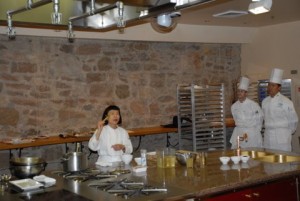I am back from World of Healthy Flavors Conference held at CIA, Greystone, Napa, CA. The presenters included food experts like other chefs and me, Harvard University Medical 
School doctors, and food manufacturers. The audience was composed of members of the large volume food service industry. These are the people who operate large central kitchens for retailers and companies like airlines (you remember that there used to be food or something like it on commercial airplanes?). During five days intensive work we engaged in lectures, demonstrations, discussions and tasting related to this year’s conference theme – creation of healthier menu items by reducing sodium, increasing the use of whole grains and fresh produce in food preparations. The aim of this meeting was to examine how the industry can help with today’s rampant health problems – obesity, high blood pressure, high blood cholesterol, etc. These are none to be caused or exacerbated by over consumption of highly processed food products, simple sugars, red meat, saturated fat and sodium.
In the following several blogs I will share with you the recipes which I presented to the conference. Eating in the Japanese way surely helps to make your diet healthier. My recipes demonstrated this. During the Conference there was a sharp comment about a significant drawback of one aspect of Japanese cuisine, that is the use of high sodium ingredients, such as shoyu (Japanese soy sauce) and miso. NONETHLESS BECAUSE they are the product of long period of fermentation of wholesome grains and soybeans and are rich in important nutrients they do have great nutritional merit. Miso and shoyu are not only culprits in the sodium problem. When we look around we realize that how much sodium we are taking in every day from our favorites food such as baked goods, snack chips, morning cereals, cured meat and cheese. To control our sodium intake we should eliminate all or most of the highly processed food products from our diet. When it comes to traditional, high-sodium items such as cheese, cured meat, miso and shoyu, we should choose those which are made in an artisanal and traditional way. These quality products have hundred times better flavor and texture than the those manufactured in a short period at large factories – some of them are designed resulting in lower sodium or lower fat content in the finished products. The increased flavor in the quality products means we actually need LESS of those products than the inferior counterparts. This leads to better flavor AND reduced sodium content. Our brain should be trained to react to good quality with less quantity. Today’s New York Times Dining Section has interesting article: Throwing the Book at Salt – warning us to reduce sodium intake. The ideas that I have presented here are part of such a plan.
